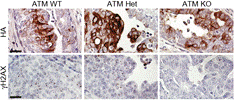Veterinary and Biomedical Sciences, Department of
Document Type
Article
Date of this Version
2-1-2005
Citation
Proceedings of the National Academy of Sciences (February 1, 2005) 102(5): 1,620-1,625. DOI: 10.1073pnas.0409022102.
Abstract
Myelin basic protein (MBP) is a major candidate autoantigen in multiple sclerosis (MS). Its immunodominant epitope, MBP 85–99, forms a complex with human leukocyte antigen (HLA)-DR2 with which multiple sclerosis is genetically associated. Copolymer 1 (Copaxone), a random amino acid copolymer [poly (Y,E,A,K)n] as well as two modified synthetic copolymers [poly (F,Y,A,K)n and poly (V,W,A,K)n] also form complexes with HLA-DR2 (DRA DRB1*1501) and compete with MBP 85–99 for binding. Moreover, two high-affinity synthetic peptide 15-mers that could inhibit binding even more effectively were previously designed. Here, we show that further-modified peptide 15-mers inhibited even more strongly (in order J5 > J3 > J2) both the binding of MBP 85–99 to HLA-DR2 and IL-2 production by two MBP 85–99-specific HLA-DR2- restricted T cells. J5, J3, and J2 also suppressed both MBP 85–99- induced experimental autoimmune encephalomyelitis (EAE) in hu- manized mice and proteolipid protein 139–151-induced EAE in SJL/J mice. Moreover, none of these previously uncharacterized peptide inhibitors crossreacted with MBP 85–99- or proteolipid protein 139–151-specific T cells. In both cases, spleen and lymph node cultures stimulated with these peptides produced large amounts of Th2 cytokines (IL-4 and IL-10), and adoptive transfer of established T cell lines suppressed disease induction. These peptide 15-mers provide specific, nonrandom sequences that appear to be at least as effective as random copolymers in suppressing EAE in several models.
Included in
Biological Phenomena, Cell Phenomena, and Immunity Commons, Immune System Diseases Commons, Medical Immunology Commons, Medical Microbiology Commons, Nervous System Diseases Commons



Comments
Copyright 2005, PNAS. Used by permission.